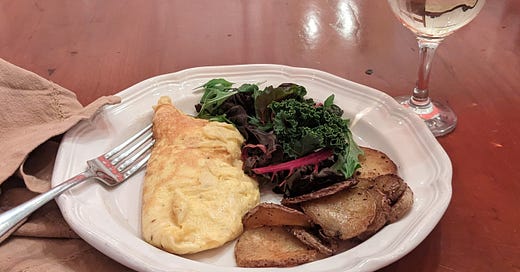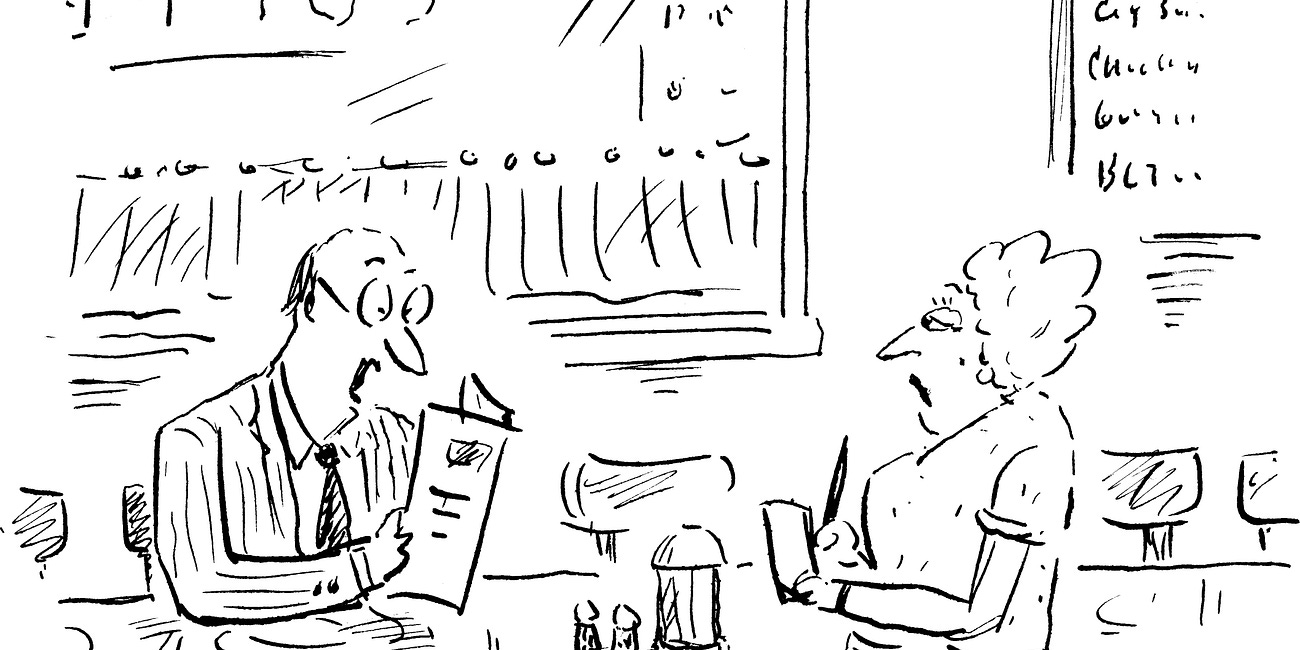The most popular America Eats! story listed on the homepage is one I wrote a year and a half ago about my inability to make an omelet. It’s a pull aside the curtain to reveal the inept wizard kind of story: I may write about food all the time but that doesn’t mean what comes out of my kitchen is a glamor shot. Maybe that’s why it’s so popular, reassuring readers and unsuspecting visitors alike that imperfection is perfectly fine. I like to think the story is amusing and it does offer an entertaining video of Julia Child demonstrating how to make a perfect omelet, so it’s not a complete wash.
Or maybe the story is so popular because perfecting such a simple dish as an omelet remains out of reach of others, no matter how hard they try. It’s not the batter’s fault—the recipe is so elementary. It’s the fumbling to land what should be a delicately rolled fluffy, slightly brown but delicately pale yellow on the plate. I know why I fail—lacking the dexterity and the quickness to flip the omelet several times over and deliver it at the right moment to the plate.
Fear in a Pan
I cooked my first omelet for a farmer in a bar in Ravenna, Ohio. The bar was the front portion of a small family restaurant that served Italian food in a town that, until the early 1960s, didn’t really appreciate anything about the Sicilian immigrants who began settling in the area in the early 1900s. Until then, the town was white a…
How exciting it was, then, to come upon Elizabeth David’s account of her omelet making. She gives directions for Omelette Molière, a recipe I couldn’t find in any other book or claimed by anyone else. [I’m going to use David’s terminology throughout this discussion. Omelette is the European spelling, especially in England and France.] The recipe diverges from the standard in several ways, starting with dismissing the requirement to purchase a special omelet pan.
But, you will say, everyone knows that the success of omelette making starts with the pan and not with the genius of the cook. And a heavy pan with a perfectly flat base is, of course, a necessity. And if you are one of those who feel that some special virtue attaches to a venerable black iron pan unwashed for twenty years, then you are probably right to cling to it.
David had such an omelet pan—she made pancakes in it. She favored a simple aluminum skillet and washed it along with everything else in her sink. “This is not perversity,” she added, “but simply the ritual which happens to suit me and my omelettes.”
In my own endeavors over the years, I placed blame on my fancy omelet pan as the cause of my misfires. Even though it remained unwashed for decades, the pan never developed the necessary seasoning. With David’s approval, I turned to one of my beat-up highly seasoned aluminum skillets.
On to the omelet making. . . .
What one wants is the taste of the fresh eggs and the fresh butter and, visually, a soft bright golden roll plump and spilling out a little at the edges. It should not be a busy, important urban dish but something gentle and pastoral, with the clean scent of the dairy, the kitchen garden, the basket of sorrel, chives, tarragon. And although there are those who maintain that wine and egg dishes don’t go together I must say I do regard a glass or two of wine as not, obviously, essential but at least as an enormous enhancement of the enjoyment of a well-cooked omelette. . . .We are not in any case considering the great occasion menu but the almost primitive and elemental meal evoked by the word: ‘Let’s just have an omelette and a glass of wine.’
The recipe is given as David presented it in her essay, An Omelette and a Glass of Wine in 1959 for a publication called Besides. As stated in Thursday’s story, David did not write her recipes in the classic manner. Her way demands that you read it through in order to gather its ingredients and understand the prescribed steps. Stops and starts are inevitable, annoyances, too, but I promise it’ll give you a more intimate experience of how to cook an omelet.
Let it be known that even I achieved a perfect omelet the first time I attempted the recipe. I chalk this up to the addition of heavy cream and especially David’s use of a narrow palette knife. The knife gives you more control over the shaking, sleight-of-hand action that everyone else claims is imperative for a perfect omelet.
ENJOY!
Omelette Molière
Beat one tablespoon of finely grated Parmesan with 3 eggs and a little pepper.
Warm the pan a minute over the fire. Put in half an oz of butter. Turn up the flame. When the butter bubbles and is about to change colour, pour in the eggs.
Add one tablespoon of very fresh Gruyère cut into little dice, and one tablespoon of thick fresh cream. Tip the pan towards you, easing some of the mixture from the far edge to the middle. Then tip the pan away from you again, filling the empty space with some of the still liquid eggs, By the time you have done this twice, the Gruyère will have started to melt and your omelette is ready. Fold it over in three with a fork or a palette knife, and slide it on to the warmed omelette dish. Serve it instantly.





Your omelette looks perfect. I always add a touch of water to the eggs before whisking. Not sure where I picked that up.
David is my hero. Thanks for this lovely essay!